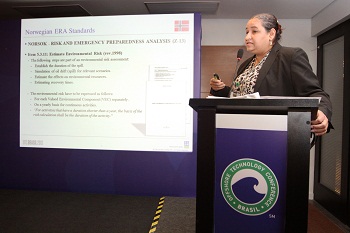Although DNV GL describes environmental risk analysis in Brazil as being in an initial phase compared to Norwegian standards, there are rules in Brazil that might require greater efforts from operators in order to prevent accidents.
Cássia Cardoso from the DNV GL Risk Advisory division presented a paper on offshore environmental risk analysis, with a comparative approach to its importance in Brazil and Norway, during a technical session on tools and methodology applied to risk and integrity, at OTC Brasil 2013.
Reducing risks is a concern to all parties involved in the oil & gas industry. Brazil’s environmental regulator Ibama recently created a task force to deal with the environmental licensing for oil exploration and production in the pre-salt areas, a challenge of new dimensions, both technically and size-wise, to Brazilian authorities.
According to Cássia Cardoso, there are regulations in Brazil that might require greater efforts from the operators in case of an accident.
“The methodologies in Norway and Brazil have several similarities, but a more detailed study shows that there are crucial points in their approaches that may require greater efforts from operators in Brazil in order to prevent accidents.This topic has crucial impact on the decision making process regarding the growth of offshore activities in Brazil”, Cássia Cardoso said.
During her presentation, she outlined the standards and methodologies used in the two countries.
Brazil
Ibama is only one of the three different government bodies that regulates this area in Brazil. The first environmental regulations were adopted in 1986. The other regulatory bodies are Agêngia Nacional de Petróleo (ANP) and Conama, and all three bodies establish requirements and procedures on how to get environmental licences in Brazil.
These are detailed requirements that demand that the licensor presents a historic analysis of environmental accidents and identifies accident scenarios in all stages of the life cycle of the installation. The licencor also needs to evaluate consequences of oil drift, conduct a vulnerability analysis and identify vulnerable areas, called vulnerable environmental components or VECs. In addition the licensor needs to work out a risk management plan.
The environmental risk shall be calculated by VEC and by oil volume category
Norway
Norwegian standards include the Norsok Risk and emergency preparedness analysis. This standard covers risk analysis and emergency preparedness associated with the exploration, drilling, production and transportation of oil resources, as well as all facilities and vessels involved in the activity. Operations and modifications of facilities, as well as decommissioning and disposal of these, are also covered.
In addition, there is the Mira standard, that applies to offshore areas in Norway, a method which aims to present the expected consequences of accidental oil spills
The methodology implies that oil spill scenarios and frequences need to be identified. It implies oil drift modelling, and the identification of VECs. The evaluation of environmental consequences needs to consider the recovery time for species and their habitat and describe the relation between oil volume and environmental consequences.
Norway has established categories of environmental damage, ranging from insignificant to serious, where an insignificant incident causes an environmental damage with a recovery time of less than one month, while a serious incident causes damage with a recovery time of more than ten years.
Main differences
One main difference between the two countries, identified by DNV GL, is that Norway does not require any predefined oil spill volume in the analysis of potential consequences in case of an accident. In Brazil, oil drift modeling has to simulate the trajectory and dispersion of the oil for scenarios with oil spill volumes up to 8m3, from 8-200 m3 and for volumes greater than 200 m3, a worst case scenario.
The Norwegian standards are on the other hand more detailed when it comes to diffentiating the oil spill scenarios in vulnerable areas. In Norway, the information on such vulnerable areas, or VECs, has to be detailed, while the level of information required in Brazil is described as “medium” by DNV GL.
Brazilian authorities have not defined a so called “risk environmental acceptance criteria”, that is an upper limit for risk which is considered acceptable by society. In Norway this is defined. Norway also requires that the companies present a contingency plan. In Brazil, this is part of the environmental study (Estúdo de impacto ambiental (EIA) and Relatório de impacto ambiental (RIMA) and the demands not defined as clearly.
In her presentation, Cássia Cardoso said that since the first version of the Brazilian methodology, changes have been implemented to better fit the IBAMA’s goals for environmental license process, but DNV GL sees the need for contiuned dialogue involving all interested parties to guarantee an “integrated development”.
“In Brazil, the development of the methodology and regulations for environmental risk analysis are still in an initial phase. Environmental Risk Analysis is at an advanced stage of development in Norway,” Cássia Cardoso concluded.
By Runa Hestmann Tierno, NBCC journalist
(runa.tierno@nbcc.com.br)
:


